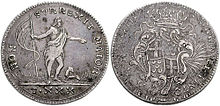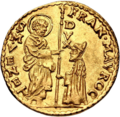Oncia

In southern Italy, theoncia(pluraloncieoronce) oronza(pl.onze) was aunit of accountduring theMiddle Agesand later agold coinminted between 1732 and 1860. It was also minted in the southern Italian territories of theSpanish Empire,and a silver coin of the same value was minted by theKnights of Malta.The name is derived from the ancient Romanuncia.It may sometimes be translatedounce.
In the medieval kingdoms ofNaplesandSicily,oneonciawas equivalent to 30tarì,600graniand 3600denari(pennies). Conventionally, a sum of money is indicated by numbers ofoncie,tarì,granianddenariseparated by full stops, thus 2.2.15.1 indicates 2oncie,twotarì,15graniand 1denaro.Although theonciawas never minted in the Middle Ages, it was the basic unit of account. The lesser denominations were minted, as was theducat(six of which equalled anoncia) and thecarlino(60 to theoncia).[1][2]Frederick IIintroduced theaugustalis,which was a quarter of anoncia.[3]
See also
[edit]Notes
[edit]- ^Eleni Sakellariou,Southern Italy in the Late Middle Ages: Demographic, Institutional and Economic Change in the Kingdom of Naples, c.1440–c.1530(Brill, 2012), p. 492.
- ^Stephan R. Epstein,An Island for Itself: Economic Development and Social Change in Late Medieval Sicily(Cambridge University Press, 1992), p. xii.
- ^Donald Matthew,The Norman Kingdom of Sicily(Cambridge University Press, 1992), p. xi.

